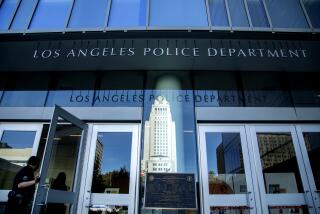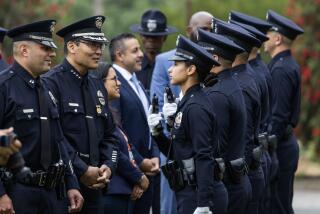Response Time of Pasadena Police Short of 6-Minute Goal
PASADENA — A city audit has concluded that police failed to respond to emergency calls within the department goal of six minutes nearly half the time during a recent 7-month monitoring period.
A manpower shortage was cited as the reason in the audit by city administrators and outside consultants.
The audit also concluded that the Police Department should eliminate two of its four helicopters and consider transferring some of the officers from a special neighborhood crime task force to other jobs.
According to the audit, officers did not meet the departmental goal of responding within six minutes to crimes that are life-threatening or in progress 48% of the time between July, 1987, and February, 1988.
The average delay was one second more than six minutes. Response times ranged from 3 minutes, 16 seconds to 16 minutes, 26 seconds.
During the monitoring period, the department had about 56 officers on patrol and was about 10 below the staffing level approved by the city.
“What I don’t understand is why can’t we fill those positions?” asked city Director Kathryn Nack. “We have the money, why don’t we have the people?”
Police Chief James M. Robenson said the department has had a difficult time finding officers.
He said it is difficult to find qualified candidates since only about one in 75 is accepted. Many potential applicants prefer to work on smaller suburban forces, he said.
Pasadena has tried to solve the problem by recruiting on college campuses around the country and setting up a toll-free telephone number to provide employment information, Robenson said.
But Robenson said the audit was wrong in assuming the shortage has affected the department’s response time to emergency calls.
He said those calls are given top priority and even if a dozen new officers were hired, it would not significantly lower response times. More patrol officers, he said, would have a greater impact on less serious calls, which are sometimes delayed while police respond to emergency calls.
Robenson also said the audit was misleading because it did not count the response time of police helicopters, which he said can reach the scene of any crime in the city in less than a minute.
He added that even if the audit were accurate, a delay of a few seconds was still well within an acceptable range.
“Sure I’d like to have the quickest response of any place, but we’re talking about just a few seconds,” he said. “If the trend is between six and seven minutes, I feel we’re delivering at least what we should.”
Police in Pomona, which is comparable to Pasadena in population, has an average response time of 7 minutes, 50 seconds. Pomona has 94 patrol officers.
The audit, which will be presented to the Board of Directors Jan. 10, was part of a series of reports commissioned by the city to study the operation of all its major departments, such as water and power and public works.
The audit largely praised the Police Department for its responsiveness to the community and innovative approach to law enforcement.
“The Pasadena Police Department can be classified as an organization on the move,” the audit stated. “Based on our analysis, the project team found no major efficiency or effectiveness problems.”
Mayor William Thomson said he was pleased with the results of the audit, saying it confirmed his belief that “we have a first-rate department.”
But Director William Paparian said the audit’s conclusions led him to believe the department has gotten away from the basics of law enforcement to pursue “sexier” and more high-profile projects.
“We ought to be going to more substance than flash,” he said. “We’ve gone off on these sexy approaches and I think it’s time we get back to the basics.”
One example, Paparian said, was the Neighborhood Crime Task Force, a special police unit formed to fight neighborhood crime and drug dealing, particularly in northwest Pasadena.
The audit praised the task force for its high number of arrests and convictions, but noted the number of felony and drug arrests have dropped.
Implications for Task Force
The audit team, which included city administrators and outside consultants, said the smaller number of arrests for serious crimes may be the first sign the 3-year-old task force has outlived its usefulness.
The audit recommended the department consider transferring some of the task force’s 18 officers to other jobs.
But Robenson said cutting back the task force would be a “disservice” to the northwest community, which still has the highest crime rate in the city.
While the number of felony and drug arrests did drop by about 20% during an 18-month period ending in 1987, the number of cases filed for prosecution remained the same, the audit said.
Robenson said the task force allows the department to focus on combatting crime in the neighborhoods by freeing up officers for foot patrols throughout the city and undercover drug enforcement.
Helicopter Unit
The audit also raised concerns about the efficiency of the department’s helicopter unit, which auditors said has more helicopters than it needs.
The unit now has four helicopters, one of which is primarily used to ferry city officials and demonstrate the capabilities of helicopters to police officers. Other cities of comparable size have two helicopters to accomplish the same work, according to the audit.
“I don’t know why we need to have our own air force with a budget of $1.1 million,” Paparian said. “I’d like to see us spend that money on bread-and-butter stuff like more neighborhood patrols.”
The audit recommended selling two of the helicopters for an annual savings of as much as $640,000.
But Robenson said to achieve those savings the department would have to eliminate daytime flights and cut back flight time from 3,750 hours a year to 1,170.
He said the department is spending about the same as other departments that have just two helicopters. For example, he said, Riverside police spent $1.3 million and Newport police spent $900,000 last year to operate two helicopters.
Robenson said having four helicopters is critical to the department’s patrol strategy because they can reach the scene of a crime faster than a patrol car and can cover much more territory.
More to Read
Sign up for Essential California
The most important California stories and recommendations in your inbox every morning.
You may occasionally receive promotional content from the Los Angeles Times.











